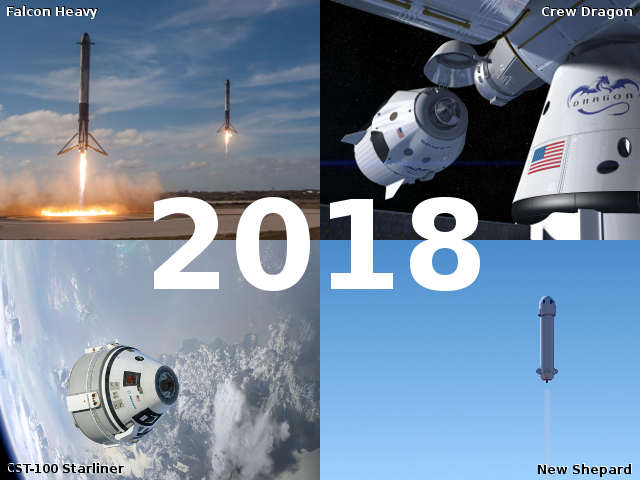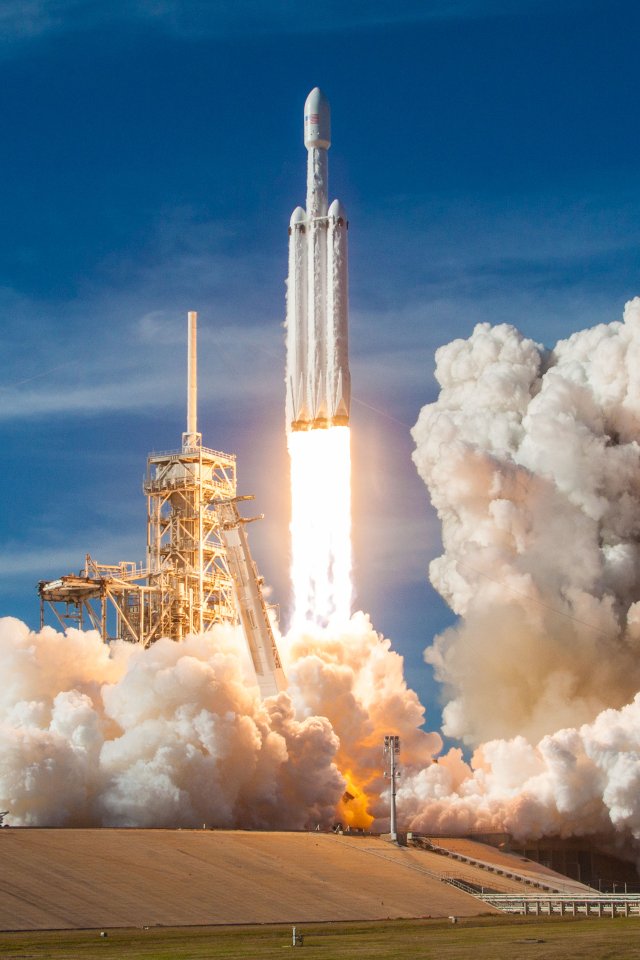Ladies and gentlemen, if you're a space flight enthusiast, this year is going to bring you some really good stuff. Actually so much of it, that I was surprised when preparing this summary. Just look at the picture I composed below.

Spacecrafts to make crucial flights this year
(sources: wikimedia commons, except for New Shepard painted by me)
(sources: wikimedia commons, except for New Shepard painted by me)
What we've got here are rockets and manned spacecrafts that are destined to take their first flight (or first manned flight) in 2018. For each of them it's been at least fourteen years now since a comparable spacecraft made its debut. This means that some of the younger readers can't remember those previous flights. Let me remained those events briefly:
- Fifteen years ago was last time that a new spacecraft took its crew to Earth orbit. That was Chinese Shenzhou (Divine Craft) in 2003. This year not one but two spacecrafts of different types are to make their first manned orbital flight.
- After fourteen years long break a private vehicle is slated to briefly hop over formal boundary of space (100 km altitude) with its crew. Yes, so much time has passed when that so called suborbital flight was made twice by X-Prize contest winner SpaceShipOne in 2004.
- Thirty years have passed since a rocket capable of lifting over 60 metric tons launched for the last time. Although not as powerful as soviet Energia rocket, Falcon Heavy will greatly increase heavy lifting capability.
Seeing this pleasant list anyone who follows spaceflight developments for any longer time will protest immediately, that bigger things were promised to us and never happened. This is right – if we got a tenth of spacecrafts, programs and initiatives ever promised, a colony on Mars would be thriving by now, while week-long trips to the Moon would be a domain of low-cost carriers. It's not a coincidence that great plans of space conquest are usually put so far in the future, that nobody remembers the promises (and promising) by that date.
This time however things are significantly different – all the flights from the list are planned for THIS year or rather the three quarters that left of it. Moreover one of the list point has already been accomplished – on February 6th we could watch live how Falcon Heavy performs a near-perfect debut flight. The rocket that brought back the ability of lifting over 60 metric tons to low Earth orbit. The one that already entered history when its booster stage returned to the launch site for a soft landing. Oh and it did that along its twin sister (see first picture). Another first was that half of the payload fairing was recovered by dedicated ship.

Falcon Heavy goes into business.
If you've got several tens of tons to be launched and a spare $90 million, call SpaceX.
(source: wikimedia commons)
If you've got several tens of tons to be launched and a spare $90 million, call SpaceX.
(source: wikimedia commons)
And though the first stage of Falcon Heavy (the central one, between the boosters) dived at great speed next to a drone ship it was supposed to land on, the mission is still a great success. Both primary and several secondary goals were achieved in first flight, showing strong resolve and growing confidence to reuse more and more elements of the rocket. The goal of opening wide the space exploration by reducing the cost of launches seems to be closer then ever, or rather as close as in pre Challenger disaster period of Space Shuttle.
Next flights from our list are scheduled to take place in August. The plan is that two new designs from Boeing (CST-100 Starliner) and SpaceX (Crew Dragon) will fly to International Space Station and return safely back to Earth. These initial flights go without crew as was the habit in old days of Moon Race. The manned flights are currently scheduled for November and December respectively.
Last but not least first manned flight of New Shepard is expected to take place this year. Developed by Blue Origin, intended to make suborbital hops is our best hope to see again what SpaceShipOne did twice fourteen years ago. However Blue Origin is known for secrecy of their developments and seems to be resistant to rush its operations, therefore delay of New Shepard manned flight is likely.
Wrapping up – the number of breakthrough missions year 2018 promises to bring is bigger than any other in my life. Not long ago I would be enormously delighted seeing one of the flights. Current schedule is like Christmas coming early this year, bringing the prospect of unpacking presents one by one until year's end 🙂
See you in following posts that I'll write while waiting.
Sources: The memory I fed with spaceflight related information over many years. Also enormous lore of historical spaceflight contained in Encyclopedia Astronautica http://astronautix.com
Hi, I found some acronyms/abbreviations in this post. This is how they expand: